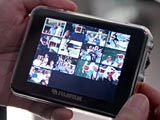RFID for patients in hospitals
Via the SJ Mercury News (sub. req.), the FDA has approved an RFID chip that you place on (not in) a body part that’s to be operated on to identify the proceedure and other info:
The system works like this: At an initial visit, the information on the operation is placed in the computer. The patient sees it on a monitor and verifies that it’s correct. The data is then printed out on the chip and then re-read by the computer. Again, the patient verifies the data.
On the day of the procedure, the patient once again verifies the chip is correct, and it is then placed on the area to be operated.
At the suggestion of the FDA, the chip will have a notice on it that it should be removed before the procedure.
This would presumably replace the current technique of using a sharpie and writing stuff on the patient like “no, the other leg!” I’m curious but a bit sceptical — on the one hand the RFID tag can hold a lot more info than you can fit on a body part (allergies, etc.), but I don’t see that making up for the immediacy of reading what’s written on the body part you’re about to operate on. Why would an RFID tag be any more likely to be read than the patient’s chart?
RFID for patients in hospitals Read More »
